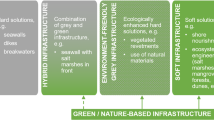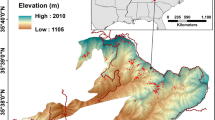Abstract
The paper addresses the influence of intense sediment transport (bed load and debris flow) on the efficiency of the structures aimed at the interception of wood logs. In the literature different devices designed to intercept woods are proposed: steel barriers, net barriers, check dam with steel bars positioned in the opening. In this paper we firstly define some fundamental dimensionless parameter governing the phenomenon, in order to determine a rational criterion to evaluate the efficiency of the different kind of devices. In particular, we deepen the interaction between slit check dams and driftwood, in both bed load and debris flow conditions. Starting from the results of this first analysis, we propose some arrangements of steel bars be installed in the check dam. Through a laboratory experimental investigation, by now conduced in simplified conditions (i.e. spherical mono-dispersed sediments), we define some criteria to obtain the best design parameters for the bars, that is their optimal disposition and spacing, in function of the logs characteristics (mainly the lengths). We investigate also the influence of different lengths of the transported woods, finding a general criterion to evaluate an overall length representing the logs ensemble.




















Similar content being viewed by others
Abbreviations
- \(B_c\) :
-
Channel width (L)
- \(B_f\) :
-
Width of the slit check dam opening (L)
- \(B_r\) :
-
Spacing among the bars (L)
- C :
-
Solid concentration (–)
- Fr :
-
Froude number (–)
- \(L_w\) :
-
Wood cylinders length (L)
- \(L_{w,av}\) :
-
Weighted average length in presence of woods of different lengths (L)
- \(n_w\) :
-
Number of woods (–)
- \(N_r\) :
-
Number of ramps (–)
- \(R_w\) :
-
Length ratio (–)
- s :
-
Ramps thickness (L)
- \(\tilde{T}\) :
-
Dimensionless time (–)
- \(T_c\) :
-
Clogging time (T)
- \(T_{cs}\) :
-
Clogging time for the sediments upstream of the check dam (T)
- \(T_{cw}\) :
-
Clogging time for the woods (T)
- TE :
-
Trapping efficiency (–)
- \(\alpha \) :
-
Channel slope (\(^{\circ }\))
- \(\alpha _s\) :
-
Inclination of the ramps with respect to the vertical (\(^{\circ }\))
- \(\lambda _r\) :
-
Ratio between the spacing of the ramps and the length of the wood cylinders (–)
- \(\varLambda _C\) :
-
Covering factor (–)
- \(\phi \) :
-
Friction angle of sediments (\(^{\circ }\))
- \(\varPhi _{w,DR}\) :
-
Number of woods passing because of the delayed release (\({\hbox {T}}^{-1}\))
- \(\varPhi _{w,i}\) :
-
Incoming number of woods in the unit time from upstream (\({\hbox {T}}^{-1}\))
- \(\varPhi _{w,p}\) :
-
Number of woods passing through the check dam in the unit time (\({\hbox {T}}^{-1}\))
- \(\varPhi _{w,t}\) :
-
Trapped quantity of driftwood in the unit time (\({\hbox {T}}^{-1}\))
- \(\rho _s\) :
-
Density of the sediments (\({\hbox {M L}}^{-3}\))
References
Armanini A (2018) Mathematical models of riverbed evolution. In: Principles of river hydraulics. Springer, Cham, Berlin, pp 131–172
Armanini A, Dellagiacoma F, Ferrari L (1991) From the check dam to the development of functional check dams. In: Di Armanini S (ed) Fluvial hydraulics of mountain regions. Lecture notes on Earth sciences. Springer, Berlin, pp 331–344
Armanini A, Fraccarollo L, Larcher M (2006) Debris flow. In: Anderson MG (ed) Encyclopedia of hydrological sciences. Wiley, London, pp 2173–2186. https://doi.org/10.1002/0470848944.hsa149 (Chap. 142)
Armanini A, Larcher M (2001) Rational criterion for designing opening of slit-check dam. J Hydraul Eng 127(2):94–104. https://doi.org/10.1061/(ASCE)0733-9429(2001)127:2(94)
Bezzola GR (2006) Schwemmholz: Probleme und Lösungsansätze. Eigenverlag der Versuchsanstalt für Wasserbau, Hydrologie und Glaziologie. ETH-Zentrum, Zurich
Braudrick CA, Grant GE (2001) Transport and deposition of large woody debris in streams: a flume experiment. Geomorphology 41(4):263–283. https://doi.org/10.1016/S0169-555X(01)00058-7
Braudrick CA, Grant GE, Ishikawa Y, Ikeda H (1997) Dynamics of wood transport in streams: a flume experiment. Earth Surf Process Landf J Br Geomorphol Group 22(7):669–683. https://doi.org/10.1002/(SICI)1096-9837(199707)22:7<669::AID-ESP740>3.0.CO;2-L
Comiti F, Lucía A, Rickenmann D (2016) Large wood recruitment and transport during large floods: a review. Geomorphology 269:23–39. https://doi.org/10.1016/j.geomorph.2016.06.016
D’Agostino V, Degetto M, Righetti M (2000) Experimental investigation on open check dam for coarse woody debris control. Dynamics of water and sediments in mountain basins. Quad Idron Montana 20:201–212
Furlan P, Pfister M, Matos J, Amado C, Schleiss AJ (2018) Experimental repetitions and blockage of large stems at ogee crested spillways with piers. J Hydraul Res. https://doi.org/10.1080/00221686.2018.1478897
Ishikawa N, Shibuya H, Katsuki S, Mizuyama T (2014) Protective steel structures against wooden debris hazards. In: Proceeding of the 6th international conference on the protection of structures against hazards conference, pp 1–14
Iverson RM (1997) The physics of debris flows. Rev Geophys 35(3):245–296. https://doi.org/10.1029/97RG00426
Kasai S, Ohgi Y, Mizoguchi I, Matsuda A, Aramaki H, Tanami M (1996) Structural characteristics of wood-debris entrapment facilities. In: Proceedings of interpraevent conference
Mazzorana B, Hübl J, Zischg A, Largiader A (2011) Modelling woody material transport and deposition in alpine rivers. Nat Hazards 56(2):425–449. https://doi.org/10.1007/s11069-009-9492-y
Ngi FS, Ngi KL, Rickenmann D, Holub M (2008) Recommendations and best practice. Deliverable D2.3 of the project: IRASMOS-Integral Risk Management of Extremely Rapid Mass Movements
Piton G, Recking A (2015) Design of sediment traps with open check dams: a review—part II: woody debris. J Hydraul Eng. https://doi.org/10.1061/(ASCE)HY.1943-7900.0001049
Piton G, Recking A (2015) Design of sediment traps with open check dams. I: hydraulic and deposition processes. J Hydraul Eng 142(2):04015045. https://doi.org/10.1061/(ASCE)HY.1943-7900.0001048
Rimböck A (2004) Design of rope net barriers for woody debris entrapment. introduction of a design concept. In: Proceeding of the international symposium interpraevent, pp 265–276
Rimböck A, Strobl T (2002) Loads on rope net constructions for woody debris entrapment in torrents. In: International congress “interpraevent”, pp 797–807
Rudolf-Miklau F, Hübl J (2010) Managing risks related to drift wood (woody debris). In: Proceedings of the international conference interprävent, pp 868–878
Ruiz-Villanueva V, Piégay H, Gurnell AM, Marston RA, Stoffel M (2016) Recent advances quantifying the large wood dynamics in river basins: new methods and remaining challenges. Rev Geophys 54(3):611–652. https://doi.org/10.1002/2015RG000514
Schalko I, Schmocker L, Weitbrecht V, Boes RM (2018) Hazards due to large wood accumulations: local scour and backwater rise. In: E3S web of conferences, vol 40. EDP Sciences, New York, p 02003. https://doi.org/10.1051/e3sconf/20184002003
Schmocker L, Weitbrecht V (2013) Driftwood: risk analysis and engineering measures. J Hydraul Eng 139(7):683–695. https://doi.org/10.1061/(ASCE)HY.1943-7900.0000728
Shibuya H, Katsuki S, Ohsumi H, Ishikawa N, Mizuyama T (2010) Experimental study on woody debris trap performance of drift wood capturing structure. J Jpn Soc Eros Control Eng 63(3):34–41
Shima J, Moriyama H, Kokuryo H, Ishikawa N, Mizuyama T (2016) Prevention and mitigation of debris flow hazards by using steel open-type sabo dams. Int J Eros Control Eng 9(3):135–144. https://doi.org/10.13101/ijece.9.135
Shrestha BB, Nakagawa H, Kawaike K, Baba Y, Zhang H (2012) Driftwood deposition from debris flows at slit-check dams and fans. Nat Hazards 61(2):577–602. https://doi.org/10.1007/s11069-011-9939-9
Takahashi T (2014) Debris flow: mechanics, prediction and countermeasures. CRC Press, Boca Raton
Uchiogi T, Shima J, Tajima H, Ishikawa Y (1996) Design methods for wood-debris entrapment. In: Proceedings international symposium interpraevent Garmisch Partenkirchen, vol 5, pp 279–288
Acknowledgements
This work was partially carried out in the frame of the collaborative international consortium, STEEP STREAMS, under the ERA-NET Cofund WaterWorks 2014 Call. The ERA-NET is an integral part of the 2015 Joint Activities developed by the Water Challenges for a Changing World Joint Programme Initiative (Water JPI). The authors are grateful to Debora Gasperi, who made a great contribution to the work during the course of her Master thesis. The authors would thank the Technicians of the Hydraulic Laboratory of the University of Trento, Andrea Bampi, Lorenzo Forti, Fabio Sartori and Paolo Scarfiello, for their valuable support during the experimental work.
Author information
Authors and Affiliations
Corresponding author
Additional information
Publisher's Note
Springer Nature remains neutral with regard to jurisdictional claims in published maps and institutional affiliations.
Electronic supplementary material
Below is the link to the electronic supplementary material.
Rights and permissions
About this article
Cite this article
Rossi, G., Armanini, A. Experimental analysis of open check dams and protection bars against debris flows and driftwood. Environ Fluid Mech 20, 559–578 (2020). https://doi.org/10.1007/s10652-019-09714-9
Received:
Accepted:
Published:
Issue Date:
DOI: https://doi.org/10.1007/s10652-019-09714-9




